AIFV
| AIFV | |
|---|---|
|
YPR-765A1 | |
| Type | Armored personnel carrier |
| Place of origin | United States |
| Service history | |
| Used by | Users |
| Wars | Yugoslav wars, anti-guerrilla operations in the Philippines, War in Afghanistan |
| Production history | |
| Variants | Variants |
| Specifications | |
| Weight | 13.6 metric tons (combat load) |
| Length | 5.26 m |
| Width | 2.82 m |
| Height | 2.62 m (to turret roof) |
| Crew | 3+7 |
|
| |
| Armor | Aluminium hull with spaced laminate steel appliqué armor on the front and sides |
Main armament | 25 mm KBA-B02 cannon (180 rounds ready; 144 in reserve) |
Secondary armament | 7.62×51mm NATO machine gun (230 rounds ready; 1,610 in reserve) |
| Engine |
Detroit Diesel Allison 6V-53T 267 hp (195 kW) at 2800 rpm |
| Power/weight | 19.29 hp/t |
| Transmission | TX100-1A |
| Suspension | Torsion bar in tube |
Operational range | 490 km |
| Speed | 61 km/h |
The AIFV (Armored Infantry Fighting Vehicle) is a tracked light armored vehicle that serves as an infantry fighting vehicle (IFV) in the armies of several countries. It is a development of the M113A1 armored personnel carrier.
History
In 1967, funded by the U.S. Army, the FMC corporation produced two prototype vehicles designated as XM765 - these were based on their experiences with the earlier XM701 vehicle, developed for the MICV-65 program. The XM765 was based on the M113A1, upgraded with an enclosed turret and firing ports, so that the infantry could fight from within the vehicle. The army evaluated the vehicle, but decided that they wanted a better protected and more mobile vehicle,[1] selecting instead the M2 Bradley.
FMC continued development as a private venture, resulting in the product improved (PI) M113A1 in 1970. The PI M113A1 had the driver and engine at the front, with an enclosed weapon station in the center of the hull and the commander seated at the rear. This arrangement meant that the commander had a very poor forward view. FMC went back to the drawing board and came up with a new design, which had the driver on the front left of the hull and the commander seated behind him. To the right of the commander was a one-man turret. The vehicle would later be designated the AIFV (armored infantry fighting vehicle).
While the US was uninterested in the design, a number of other governments were interested in the vehicle, which was simpler, lighter, and cheaper than the Bradley. After a series of demonstrations and the delivery of four evaluation vehicles in 1974, the Netherlands government placed an order for 880 of the vehicles in 1975, which were designated YPR-765 when they entered service. Some changes were made at the request of the Dutch government, including shifting the weapon station to the right side and moving the commander behind the driver. The Netherlands ordered 2,079, of which 815 were produced locally under license. Under the YPR-2000 program, virtually all Dutch vehicles were upgraded to YPR-765A1 standard and are easily identified by the 3-tone NATO camouflage pattern. During the war in Afghanistan, several vehicles were fitted with additional armour.
The Philippines also received 45 vehicles in 1979, these were intended to take 25mm cannons, although some were later modified to fit 12.7mm machine guns.
In 1979, Belgium placed an order for 514 AIFV-B (to be produced locally) along with 525 M113A-B (similar to the M113A2). The first vehicles were delivered in 1982.
Turkey selected the AIFV in 1989, after a competition involving the Alvis Vickers Warrior IFV and United Defense LP Armoured Infantry Fighting Vehicle. The total value of the contract for 1,698 vehicles was US$1.076 billion. The first 285 hulls were produced in Belgium, the remaining vehicles were produced entirely in Turkey. A little way into the production run, with 200 vehicles completed, the Turkish AIFV specification was updated to include a more powerful power pack developing 300 horsepower, an Allison X-200-4 transmission and hydrostatic steering from the M113A3. During the production run, a number of changes were made to the armament of the vehicle, including different turret packages, and power packs.
Description (per Dutch variant)
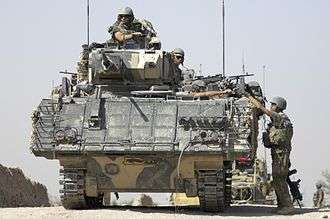
The hull of the vehicle is made of welded aluminum, with spaced steel laminate armor bolted onto the side and front. The voids of the armor are filled with polyurethane foam, which gives the vehicle extra buoyancy when travelling in the water.
The engine sits on the front right of the hull, behind a hatch that can be used to remove the complete powerpack. The powerpack is similar to the M113A1, except for a larger radiator capacity and turbocharger. The transmission is also fitted with heavy duty components from the M548 tracked cargo carrier. Immediately to the left of the engine is the driver, above whom is a hatch that opens to the right. The driver has four M27 day periscopes. The driver's center periscope can be replaced by a passive infra-red periscope for night driving. The commander sits immediately behind the driver, and has a cupola that can be completely traversed. The cupola has five periscopes, four of which are M17 day periscopes, the fifth has 1x to 6x variable magnification.
The turret is fitted on the right side of the hull behind the engine. The turret, which has electro-hydraulic traverse, can elevate from -10 to +50° and can traverse and elevate at a speed of 60°/sec. The turret mounts an Oerlikon Contraves 25 mm KBA-B02 cannon with a dual ammunition feed and 180 rounds of ready use ammo, with another 144 rounds stored in the hull. Mounted to the left of this gun is a 7.62 mm FN MAG machine gun, which has 230 rounds of ready ammo, with a further 1,610 in the hull.
The troop compartment is at the rear of the hull; a large power operated ramp allows access through the rear of the vehicle, a door is also provided in the ramp. Additionally a single piece hatch covers the top of the troop compartment. The compartment contains seven troops in the Dutch variant, with six sitting back to back facing outwards and a single passenger sitting between the command and the turret facing backwards. There are two firing ports in each side of the hull and a single firing port in the rear. The side firing ports are provided with M17 periscopes, the rear one is fitted with a M27 periscope.
Variants
Belgian service variants
- AIFV-B — A revised Dutch variant that was fitted with the same suspension as the M113A1-B (similar to the M113A2), an NBC system and a Halon fire suppression system; it entered service in September 1985. Surplus vehicles have been sold to Chile, Indonesia, and the Philippines, with the remaining carriers being phased out in favor of wheeled vehicles.
- AIFV-B-C25 with a 25 mm KBA-B02 cannon — with smoke grenade launchers fitted on the side of the turret
- AIFV-B-MILAN with a MILAN anti-tank missile launcher
- AIFV-B-.50 with a 12.7 mm CWS cuppola, 2 Lyran 71mm mortars and a pintle mount for a MILAN missile launcher.
- AIFV-B-CP — command post vehicle with a 12.7mm cupola (M113 type), a tent, generator and telescopic mast.
- AIFV-B-TRG — driver training vehicle.
Dutch variants[2]
(the pantser-rups designation means armoured-tracked)
- YPR-765 pri (pantser-rups-infanterie) — basic infantry fighting vehicle with a 25-mm KBA-B02 cannon and a coaxial MAG machine gun in a turret; crew of three plus seven passengers (normally only five carried); outward-facing bench seats in the rear compartment.
- YPR-765 pri.50 — armoured personnel carrier with a .50-caliber M2 HB machine gun on an M113-type cupola in place of a turret.
- YPR-765 prco-series (pantser-rups-commando)
- YPR-765 prco-B — company commander's vehicle with the same turret as the pri; crew of six plus two passengers; folding table in the rear compartment with two inward-facing seats on either side.
- YPR-765 prco-C-1 — battalion commander's vehicle with a .50-caliber M2 HB machine gun on an M26 cupola; crew of five plus four passengers; folding table in the rear compartment with a three-seat bench on the left and two seats on the right, all facing inward.
- YPR-765 prco-C-2 — battalion fire control center with a .50-caliber M2 HB machine gun on an M26 cupola; crew of seven plus one passenger; rear compartment as for C-1.
- YPR-765 prco-C-3 — mortar fire control vehicle with a .50-caliber M2 HB machine gun on an M26 cupola; crew of four plus one passenger; a folding table in the rear compartment, with two inward-facing seats on left.
- YPR-765 prco-C-4 — anti-aircraft command vehicle with a .50-caliber M2 HB machine gun on an M113-type cupola; crew of five plus two passengers; folding table in the rear compartment with an inward-facing, three-seat bench on the left.
- YPR-765 prco-C-5 — observation vehicle for artillery units with a .50-caliber M2 HB machine gun on an M113-type cupola; crew of five; rear compartment as for C-3.
- YPR-765 prrdr (pantser-rups-radar) — radar vehicle fitted with a ZB-298 battlefield surveillance radar, armed with a .50-caliber M2 HB machine gun on an M113-type cupola; crew of four plus two passengers; folding table in the rear compartment, with one inward-facing seat on either side.
- YPR-765 prrdr-C — radar command vehicle. Withdrawn.
- YPR-765 prgwt (pantser-rups-gewondentransport) — ambulance vehicle (literally: "casualty transport" since in Dutch military terms, an ambulance carries more medical equipment); unarmed; crew of three plus five passengers; rear compartment has two forward-facing seats on the left, bins for the personal equipment of the wounded on either side, and can hold two stretchers on either side, suspended from chains.
- YPR-765 prmr (pantser-rups-mortiertrekker) — tractor for MO-120-RT 120-mm mortar (mortiertrekker = mortar tractor) with a .50-caliber M2 HB machine gun on an M26 cupola; crew of seven, including mortarmen; rear compartment has an inward-facing, three-seat bench on the left and a mortar ammunition rack on the right.
- YPR-765 prv (pantser-rups-vracht) — cargo vehicle (vracht = cargo, freight) with a .50-caliber M2 HB machine gun on an M113-type cupola; crew of two; empty rear compartment with a folding safety screen between the crew and cargo.
- YPR-765 prat (pantser-rups-anti tank) — tank destroyer armed with an Emerson TOW Under Armor turret as on the M901 ITV and a MAG machine gun on a pintle mount; crew of four; rear compartment holds a rack with missile reloads on the left, an inward-facing bench seat and various equipment (such as TOW ground launcher) on the right.
- YPR-806 prbrg (pantser-rups-berging) — armoured recovery vehicle; in fact, it is based on a modified M113 chassis and hull but using AIFV automotive components.
Philippine service variants
The Philippine Army uses a mixed variant of earlier AIFVs similar to the Dutch YPR-765, and later variants from Turkey based on the ACV-300.
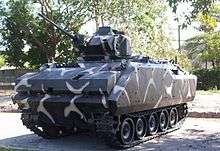
- AIFV-25 - basic infantry fighting vehicle armed with a 25 mm KBA-B02 cannon and a coaxial machine gun
- AIFV-ARV - armored recovery vehicle
- ACV-300 APC - with a 12.7 mm M2 machine gun in a shielded gun cupola
- ACV-300 ARV - armored recovery vehicle
Turkey
Service variants
- ACV-AAPC (advanced armored personnel carrier) — with a one-man turret with a 12.7 mm machine gun and a7.62 mm machine gun; 13 troops carried.
- ACV-AIFV
- AIFV with FMC EWS (assembled by DAF Special Products) turret with a 25 mm Oerlikon Contraves 25 mm cannon and a coaxial 7.62 mm machine gun
- AIFV with Giat Dragar turret with a 25 mm M811 cannon and a coaxial 7.62 mm machine gun.
- ACV-ATV — Armored Tow Vehicle. Fitted with a Norwegian one-man turret with two BGM-71 TOW missiles in a ready to launch position, and four troops carried.
- ACV-AMV — Armored Mortar Vehicle. Fitted with an 81 mm mortar and a 7.62 mm machine gun.
Turkish private variants
- 120mm AMV — A private venture, armed with a TDA 120mm recoiling mortar in the rear of the vehicle. Not in service.
- ACV-IFV Sharpshooter — IFV with FNSS Sharpshooter Turret. This variant is now being exported to Malaysia ("Adnan").
- ACV with HMTS — armed with four Hellfire missiles in the ready to fire position.
- ACV-300 — Fitted with a 300 hp powerpack similar to the M113A3, but with high power.Template:Clarifaction needed
- ACV-350 — Fitted with a 350 hp powerpack.
- ACV-S — A stretched version of the AIFV with an additional road wheel and extra armour giving resistance to 14.5mm AP projectiles, with an upgraded 350 or 400 hp powerpack. Weight is 18,000 kg. A variety of turrets are available, including 12.7mm, 25mm (FNSS Sharpshooter Turret) and 30 mm as well as an Eryx missile launcher and 120mm mortar turret.
UAE variants
- ACV-RV (Armored Recovery Vehicle)
- ACV-AESV (Armored Engineering Squad Vehicle)
- ACV-AFOV (Armored Artillery FO Vehicle)
- ACV-ACPV (Armored Command Post Vehicle)
Note: all are ACV-350 and fitted with air-conditioning and an over-pressure NBC system.
Operators
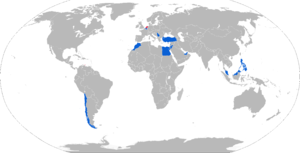
Current Operators
 Bahrain, 25 Netherlands-origin YPR-765 ACV delivered in 1996,[3](p29) 42 Belgium-origin AIFV-IFV delivered in 2008,[4] 8 (est.) Belgium-origin AIFV-APC delivered in 2008[4]
Bahrain, 25 Netherlands-origin YPR-765 ACV delivered in 1996,[3](p29) 42 Belgium-origin AIFV-IFV delivered in 2008,[4] 8 (est.) Belgium-origin AIFV-APC delivered in 2008[4].svg.png) Belgium, 190 of 514 vehicles originally delivered, being replaced by MOWAG Piranha III
Belgium, 190 of 514 vehicles originally delivered, being replaced by MOWAG Piranha III Chile, YPR-765s purchased from the Netherlands and 169 AIFV-Bs purchased from Belgium.
Chile, YPR-765s purchased from the Netherlands and 169 AIFV-Bs purchased from Belgium. Egypt, More than 1,000 YPR-765s purchased from the Netherlands and Belgium since 1996.
Egypt, More than 1,000 YPR-765s purchased from the Netherlands and Belgium since 1996.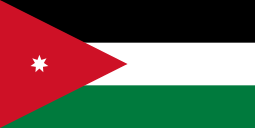 Jordan, 441 YPR-765s purchased from the Netherlands, 58 AIFV-Bs purchased from Belgium.
Jordan, 441 YPR-765s purchased from the Netherlands, 58 AIFV-Bs purchased from Belgium. Lebanon, 16 ex-Belgian AIFV-B-C25 vehicles.
Lebanon, 16 ex-Belgian AIFV-B-C25 vehicles. Morocco, 90 ex-Belgian AIFV-B-C25 and 20 AIFV-B-.50, delivered 2008.
Morocco, 90 ex-Belgian AIFV-B-C25 and 20 AIFV-B-.50, delivered 2008. Malaysia, 211 vehicles received,plus previous 111 KIFV variants known as MIFV(Malaysian Infantry Fighting Vehicle)
Malaysia, 211 vehicles received,plus previous 111 KIFV variants known as MIFV(Malaysian Infantry Fighting Vehicle) Philippines, 58 vehicles, composed of 45 AIFV-25 and 6 AIFV-ARV received from the United States in 1979,[5] 6 ACV-300 APCs and 1 ACV-ARV received from FNSS of Turkey in 2010 and 2004, respectively.[6]
Philippines, 58 vehicles, composed of 45 AIFV-25 and 6 AIFV-ARV received from the United States in 1979,[5] 6 ACV-300 APCs and 1 ACV-ARV received from FNSS of Turkey in 2010 and 2004, respectively.[6] Turkey, 2,249 were produced under licence (1,698 between 1990-2000 and 551 between 2001-2004)
Turkey, 2,249 were produced under licence (1,698 between 1990-2000 and 551 between 2001-2004)
- 1,380 × AAPC
- 650 × AIFV
- 48 × ATV
- 170 × AMV
 United Arab Emirates, 133 vehicles received from Turkey.
United Arab Emirates, 133 vehicles received from Turkey. Serbia, 1 YPR-765 seized from the Netherlands UN peace keepers in war in Bosnia and Hercegovina.
Serbia, 1 YPR-765 seized from the Netherlands UN peace keepers in war in Bosnia and Hercegovina.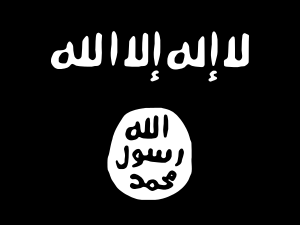 Islamic State, 3 YPR-765 vehicles seized from Egypt (Former Royal Netherlands Army, bought in 2010)
Islamic State, 3 YPR-765 vehicles seized from Egypt (Former Royal Netherlands Army, bought in 2010)
Former operators
 Netherlands, over 2,000 vehicles. Known locally as the YPR-765. All have been replaced by a combination of CV9035NL, Fennek and Boxer vehicles.[7]
Netherlands, over 2,000 vehicles. Known locally as the YPR-765. All have been replaced by a combination of CV9035NL, Fennek and Boxer vehicles.[7]
References
- Jane's Armour and Artillery 2005-2006
- SIPRI Database
- R.P. Hunnicutt (1999). Bradley, A History of American Fighting and Support Vehicles. ISBN 0-89141-694-3.
Notes
- ↑ GlobalSecurity.org. "XM765 Armored Infantry Fighting Vehicle (AIFV)". Archived from the original on 26 August 2006. Retrieved 2006-08-23.
- ↑ 1TH 9-3320 Technische Handleiding Gevechtsvoertuig, Pantser, Rups YPR-765: Universeel en afgeleide versies. Bediening en 1e Echelons Onderhoud (Technical Manual Fighting Vehicle, Armoured, Tracked YPR-765: Universal and derivative versions. Operation and 1st Echelon Maintenance) Royal Netherlands Army, 12 August 1983
- ↑ Wezeman, Pieter; Wezeman, Siemon (1996). Dutch Surplus Weapons. Bonn: Bonn International Center for Conversion.
- 1 2 Stockholm International Peace Research Institute. "Transfers and licensed production of major conventional weapons". Retrieved 2011-12-10.
- ↑ Federal Research Division, United States Library of Congress. "Country Studies - Area Handbook Series: Philippines". Archived from the original on 28 August 2006. Retrieved 2006-08-23.
- ↑ Armed Forces of the Philippines. "AFP ACQUIRES ARMORED RECOVERY VEHICLE (ARV)". Archived from the original on 2011-06-24. Retrieved 2013-05-14.
- ↑ Defensie krant. "CV-90 voor bereid op de toekomst" (PDF) (in Dutch). Directie Voorlichting Ministerie van Defensie. pp. 10–11. Archived from the original (PDF) on 2007-09-30. Retrieved 2006-08-23.
